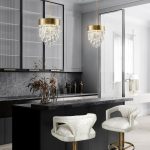
The use of colors has always been an essential part of designing or creating an ambiance. Whether it is in fashion, art or interior decoration, colors have the power to enhance the look, and feel of any setting. Similarly, lighting hue is also an important aspect that contributes significantly to our mood and well-being. In this article, we will explore the vibrant spectrum of lighting hue, and how it impacts our psyche and overall health.
Understanding Lighting Hue
Lighting hue or color temperature is measured in Kelvin (K) and is determined by the color of light emitted from a light source. A warm color temperature ranges from 2700-3000K, while a cool temperature is from 4000-5000K. A higher Kelvin rating indicates a cooler light while a lower Kelvin rating indicates a warmer light.
Effects of Warm Lighting Hue
Warm lighting hues have a color temperature of 2700-3000K and are known to provide a relaxing and comfortable atmosphere. They are ideal for creating a cozy ambiance and are commonly used in residential settings, restaurants, and cafes. The warm hues are believed to increase dopamine levels, stimulate the appetite, and create a relaxing environment.
Effects of Cool Lighting Hue
Cool lighting hues have a color temperature of 4000-5000K and are known to create a natural and refreshing atmosphere. They are ideal for precision workspaces such as hospitals, schools, and offices. Cool hues are believed to increase productivity, alertness, and concentration. They are also known to suppress melatonin production, which in turn, helps regulate circadian rhythms.
Applications of Lighting Hue
The use of lighting hue is not limited to residential and commercial settings. It is also used in therapeutic applications, specifically in color therapy or chromotherapy. Chromotherapy is a holistic practice that uses colors to balance the body’s energy centers or chakras. It is believed that colors have a profound effect on our physical, spiritual, and mental health.
Color Therapy
Color therapy works by exposing the body to colored light, either through visualizations, massages, or light-emitting devices. Each color has a specific frequency that corresponds to a particular energy center or chakra. For instance, red is believed to stimulate energy, blue is known to promote relaxation and calmness, while yellow is believed to foster emotional stability.
Light Therapy
Light therapy uses light-emitting devices to treat a wide range of physical and mental health conditions such as seasonal affective disorders (SAD), insomnia, and depression. The devices emit bright light with a specific color temperature that mimics natural sunlight, which in turn, helps regulate our circadian rhythm.
Lighting hue is an essential aspect that influences our mood, productivity, and overall wellbeing. Whether it is used to enhance the ambiance of a living space, create a warm and cozy atmosphere, or promote healing through chromotherapy or light therapy, it is clear that lighting hue has remarkable effects on us. It is therefore important to understand the science behind it and use it to our advantage for the betterment of our health and wellbeing.







